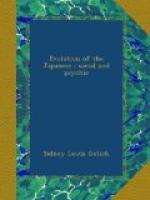The way in which Japanese regard the transformations produced by the “restoration” of the present Emperor, upon the overthrow of the “Bakufu,” or “Curtain Government,” may be judged from the following graphic paragraph from The Far East:
“The Restoration of Meiji was indeed the greatest of revolutions that this island empire ever underwent. Its magic wand left nothing untouched and unchanged. It was the Restoration that overthrew the Tokugawa Shogunate, which reigned supreme for over two centuries and a half. It was the Restoration that brought us face to face with the Occidentals. It was the Restoration that pulled the demigods of the Feudal lords down to the level of the commoners. It was the Restoration that deprived the samurai of their fiefs and reduced them to penury. It was the Restoration that taught the people to build their houses of bricks and stones and to construct ships and bridges of iron instead of wood. It was the Restoration that informed us that eclipses and comets are not to be feared, and that earthquakes are not caused by a huge cat-fish in the bottom of the earth. It was the Restoration that taught the people to use the “drum-backing” thunder as their messenger, and to make use of the railroad instead of the palanquin. It was the Restoration that set the earth in motion, and proved that there is no rabbit in the moon. It was the Restoration that bestowed on Socrates and Aristotle the chairs left vacant by Confucius and Mencius. It was the Restoration that let Shakspere and Goethe take the place of Bakin and Chikamatsu. It was the Restoration that deprived the people of the swords and topnots. In short, after the Restoration a great change took place in administration, in art, in science, in literature, in language spoken and written, in taste, in custom, in the mode of living, nay in everything” (p. 541).
A natural outcome of the Restoration is the exuberant patriotism that is so characteristic a feature of New Japan. The very term “ai-koku-shin” is a new creation, almost as new as the thing. This word is an incidental proof of the general correctness of the contention of this chapter that true nationality is a recent product in Japan. The term, literally translated, is “love-country heart”; but the point for us to notice particularly is the term for country, “koku”; this word has never before meant the country as a whole, but only the territory of a clan. If I wish to ask a Japanese what part of Japan is his native home, I must use this word. And if a Japanese wishes to ask me which of the foreign lands I am a native of, he must use the same word. The truth is that Old Japan did not have any common word corresponding to the English term, “My country.” In ancient times, this could only mean, “My clan-territory.” But with the passing away of the clans the old word has taken on a new significance. The new word, “ai-koku-shin,” refers not to love of clan, but to love of the whole nation. The conception




